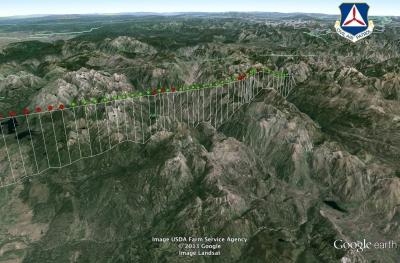Searching For Missing Bonanza Believed Down In Rugged Terrain
When a single engine plane goes down in the continental U.S., Civil Air Patrol’s cell phone and radar tracking experts are certain to be involved. Their mission – reduce the search area from thousands of square miles to the actual crash site or within a couple of square miles – is urgent, because reducing the crash-to-rescue time saves lives.

Searchers for a single-engine airplane believed downed in snowy, mountainous central Idaho are relying on CAP’s cutting-edge radar analysis as they try to find the California family of five aboard the missing Beech Bonanza.
Lt. Col. John Henderson of CAP’s 10-member National Radar Analysis Team was able to detect and map the plane’s radar track until just before the aircraft apparently began its descent Sunday. Piloted by Dale Smith of San Jose, CA, and carrying his son, his son’s wife, his daughter and her fiancé, the Bonanza was bound from Baker City, Ore, to Butte, MT. The Radar Analysis Team worked hand-in-hand with CAP’s two-man Cell Phone Forensics Team, and everyone’s analysis of the clues and data led to the same conclusions. “The cell phone data stopped about a minute before the plane dropped off of radar,” said Maj. Justin Ogden, a CAP cell phone forensics expert. “Our data correlated with the radar analysis team’s regarding the plane’s location at that time.”
CAP’s radar analysis track record is impressive. “It can be extremely accurate,” said Henderson. “Over 90 percent of the time we narrow the search area based on forensics information. We’ve come within 65 feet of where a crash occurred and sometimes miles. It depends on the radar environment.”
In 13 years, Henderson estimated, he’s participated in more than 600 missions with “well over 150 finds” and about 45 lives saved – but the Idaho mission involves some serious obstacles. The Bonanza was flying above extremely rugged, snow-covered terrain, both elements that can interfere with radar tracking. As a result, the track ended when it was still “well above ground,” said Henderson, a CAP volunteer member for more than 20 years.
That means the plane “could have traveled miles” before landing, he said. “We just don’t know what he did after we lost radar coverage.”
“How he crashed and the snowfall are huge factors,” he said, adding, “the snowfall can cover the crash site.”
Without radar analysis or cell phone forensics searches for a downed plane can prove daunting. “Pilots would be just flying around trying to spot wreckage,” Henderson said.
Idaho Wing Commander Col. Mike Vorachek said CAP is providing high-bird communication links today, while four helicopters searched for the missing plane. “We’re yielding our airspace to the helicopters, because they can get so much lower,” he said. On Tuesday and Wednesday, Vorachek said CAP aircrews flew more than 20 hours over the search area.
As of Friday, the aircraft had not been located.
(Image provided by the CAP)
 ANN's Daily Aero-Linx (05.02.24)
ANN's Daily Aero-Linx (05.02.24) ANN's Daily Aero-Term (05.02.24): Touchdown Zone Lighting
ANN's Daily Aero-Term (05.02.24): Touchdown Zone Lighting Aero-News: Quote of the Day (05.02.24)
Aero-News: Quote of the Day (05.02.24) ANN FAQ: Contributing To Aero-TV
ANN FAQ: Contributing To Aero-TV NTSB Final Report: Cirrus Design Corp SR20
NTSB Final Report: Cirrus Design Corp SR20



